CES Highlights Solutions, Possible Way Forward
 We had a major argument with ourselves this month on whether we would or wouldn’t go to CES. We had serious doubts that Gary Shapiro and the CTA (Consumer Technology Association) could really pull it off.
We had a major argument with ourselves this month on whether we would or wouldn’t go to CES. We had serious doubts that Gary Shapiro and the CTA (Consumer Technology Association) could really pull it off.
Spoiler … we should have stayed longer.
Shapiro was right when he said, “Now, this show will be a little messy, we know that. But innovation is messy.”
We were able to see companies/products we wanted to see on the show floor and still take in sessions we might otherwise have missed.
Even though they missed a golden opportunity, we do understand that a number of firms elected not to participate this year. However, we think it’s time to retire the phrase … out of an abundance of caution. It reminds us of the old Life Cereal Mikey commercial — https://tinyurl.com/2p8c2cf2.
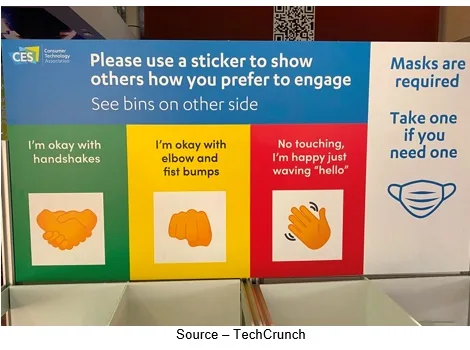 But knowing we were going to an event where everyone had to have their shots and tested negative (thanks to Abbott’s free Self-Test kits), wore masks and let you know how to greet others, made the event feel … OK.
But knowing we were going to an event where everyone had to have their shots and tested negative (thanks to Abbott’s free Self-Test kits), wore masks and let you know how to greet others, made the event feel … OK.
There were still more than 2300 exhibitors (800+ start-ups) and the 44,000 plus attendees still had trouble taking it all in. That’s because consumer technology touches every aspect of our lives.
Steve Koenig, CTA’s VP of Research, laid the groundwork for the complexity in his opening Tech Trends to Watch session discussing the big trends that are underway and a very condensed but informative look at what to expect in the sessions and on the show floor.
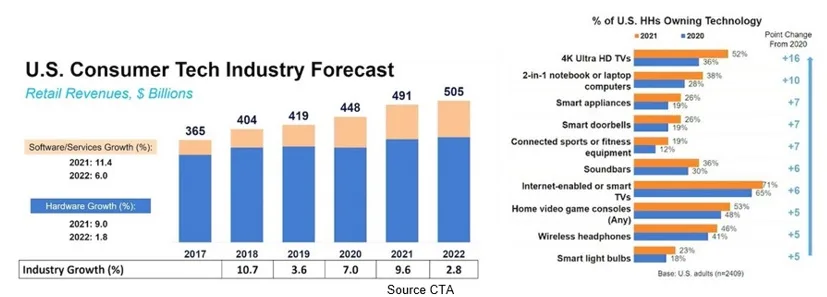 In addition to steady growth in computer/communications technology and home entertainment, the event has become the event to show the latest in vehicles (electric/autonomous cars, bikes, boats, aerial transportation), space tech (yes, a spaceship and VTOL craft), smart home and food technology, digital personal/health/lifestyle guidance and well … everything. CES is clearly the place to show off products, technology.
In addition to steady growth in computer/communications technology and home entertainment, the event has become the event to show the latest in vehicles (electric/autonomous cars, bikes, boats, aerial transportation), space tech (yes, a spaceship and VTOL craft), smart home and food technology, digital personal/health/lifestyle guidance and well … everything. CES is clearly the place to show off products, technology.
There was a lot of noise about the Metaverse; but as we said, noise. We’ve been talking about it for years and maybe in four-five years, it will be more than just a gaming environment. We’ll see.

Two of the best ways to get a quick overview for members of the media are the ShowStoppers and CES Unveiled events. In three to four hours, you can check out new tools, toys and products from hundreds of firms.
They provide a good bridge to catch up on some of the advances for content production/distribution/viewing

When you see a car that changes color at the click of a button, an autonomous tractor and theater-size home entertainment screens, you know there’s more to the industry than home electronics.

Next-generation chips from AMD, Nvidia and Intel will be powering the new laptop and desktop systems from Asus, Acer, HP, Lenovo, Alienware and Dell that will feature some large, eye-popping monitors.
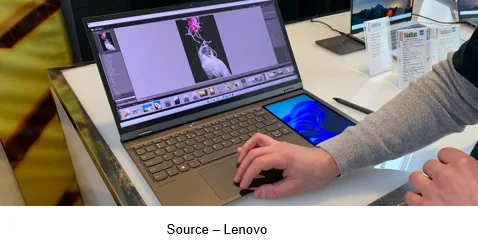
We’re thinking about upgrading to the new 17-in Lenovo ThinkBook Plus Gen 3 with a secondary color LCD display next to the keyboard around mid-year.
While the same technologies are used with the latest production workstation systems, they somehow look brighter, sharper on the new home entertainment screens.
According to Bob Raikes, editor of Display Daily and a screen tech expert, a whole new generation of thinner form factors and enhanced display performance is being introduced for people who take their home viewing seriously. However, it’s going to be confusing for consumers as they try to choose between OLED, QD-OLED and MiniLED products.

OLED (organic light-emitting diode) uses self-lighting pixels and is backlight free with higher brightness for great images, superior clarity and details.
QD-OLED (quantum dot-OLED) uses quantum physics and vision science to give you stunning color, dazzling details and a dynamite experience.
MiniLED promises a wide color standard, more contrast and improved HDR (high dynamic range) performance.
All it means is you’re going to have to check them out side-by-side with 4K and 8K content and hope you buy the right one.
Screen, Content Standards
Of course, if you’re a free OTA (over-the-air) broadcast person, you’ll want to make certain the new screen is ATSC 3.0 (NextGen TV) enabled. It’s a new audio/video technology that’s supposed to be available “soon.”
The UHD Alliance also discussed its progress on the filmmaker mode setting for new screens. Already on most new sets, the setting disables post processing such as motion smoothing so you can see content the way filmmakers intended, including original aspect ratio, color and frame rates.
What impressed us most about this year’s CES was the focus major firms had not just on their products/technology but more importantly, having a positive impact on the world we live in. For example, Goodyear showed off new tires that were made from 70 percent sustainable material with the stated goal of making tires from 100 percent sustainable materials by 2030 … that’s awesome!
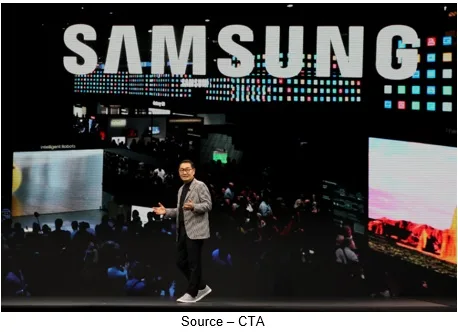
Instead of hyping all of the new stuff Samsung was unveiling at the show, the company’s head of the DX (device experience) division, J.H. Han, devoted his keynote to encouraging the industry to make products that are “in harmony with our planet to create a more sustainable world.”
Leading by example, he pointed out how the company’s Carbon Trust-certified chips reduced carbon emissions by nearly 700,000 tons. In addition, Samsung’s visual display business is working to use 30 times more recycled plastics and is expanding the use of recycled materials in its mobile products and home appliances. According to Han, all of the company’s TV boxes include recyclable materials and its Eco-Packaging program will be transforming cardboard boxes into cat houses, side tables and furniture items.
Samsung also developed and is making available open source SolarCell Remote technology to eliminate hundreds of millions of batteries from landfills.
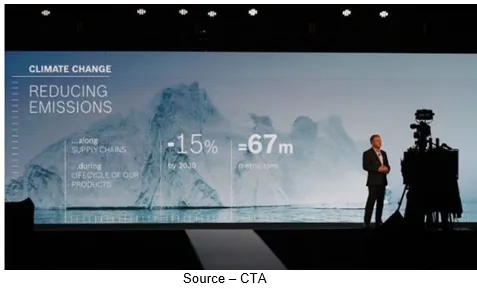
Rather than focusing on all of their new sexy products/services; Bosch, Panasonic, Amazon, Dell, IBM and a number of industry exhibitors were more interested in passing along ideas on what they were doing to reverse climate change and improve our environment.
Mike Mansuetti, president of Bosch North America, focused on how the firm is working to reduce supply chain emissions by 67M metric tons–20 times greater than their 2018 baseline year and is sharing its experiences openly with other industry players with their carbon neutrality work.
Dell has set a moonshot goal for 2030 sustainability that includes reusing/recycling equivalent product for every product customers purchase. All packaging will be from recycled/renewable materials and half their products will be made from recycled/renewable materials.
Sustainability isn’t a new focus for many organizations in the industry. For example, OWC has been using renewable solar/wind energy and practicing packaging recycling for more than 10 years. Now it is a major goal for firms large and small.
CES 2022 just might mark the shift of the industry’s event from traditional consumer electronics (computers, TVs, smartphones, stuff) to an event that shows how digital technology can improve transportation, health, food production/processing, entertainment and home products.
We’ll see what next year brings; but you can bet every conference, convention, film festival and awards event management team will be spending their time in D.C. at CTA’s headquarters learning what they need to do going forward.
Of course, it goes without saying that CES 2023 is going to be impossible – i.e., more expensive (and scarce) hotel rooms, hour-long waits for cabs/rideshares, more exhibitors, more crowds.
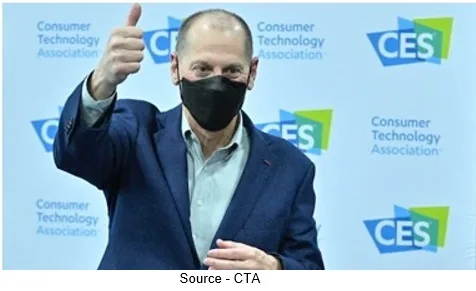 Oh, and Gary? … CES 2022 wasn’t that messy!
Oh, and Gary? … CES 2022 wasn’t that messy!
# # #
Andy Marken – [email protected] – is an author of more than 700 articles on management, marketing, communications, industry trends in media & entertainment, consumer electronics, software and applications. Internationally recognized marketing/communications consultant with a broad range of technical and industry expertise especially in storage, storage management and film/video production fields. Extended range of relationships with business, industry trade press, online media and industry analysts/consultants.